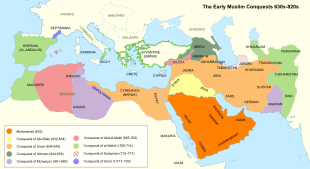| Part of a series on |
| Forced labour and Slavery |
|---|
 |


Slavery in the Umayyad Caliphate refers to the chattel Slavery taking place in the Umayyad Caliphate (661–750), which comprised the majority of the Middle East with a center in the capital of Damascus in Syria.
The slave trade in the Umayyad Caliphate was massive and expanded in parallell with the Umayyad Imperial conquests, when non-Muslim war captives as well as civilians were enslaved, and humans were demanded by tribute and taxation from subjugated people. The slave trade was a continuation of the slave trade of the preceeding Rashidun Caliphate except in size, which was parallelled by the massive Imperial conquests.
When the governing elite of the Caliphate established a permanent urbanized residence, the institution of slavery expanded in parallell with the growing access as well as the needs of a new urbanised and more sophisticated state apparatus. The system of harem sexual slavery, as well as military slavery of male slaves, expanded during this period, though they would not be fully developed until the succeeding Abbasid Caliphate.
© MMXXIII Rich X Search. We shall prevail. All rights reserved. Rich X Search
